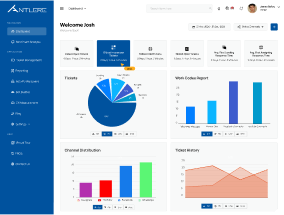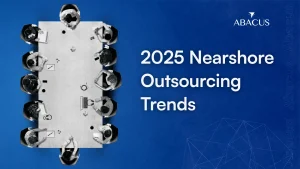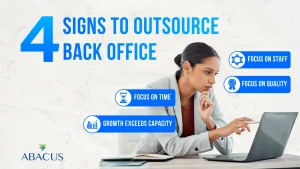Staffing, Training, and Systems: Preparing Your Team for the Holiday Season Surge
The Holiday Season has become the ultimate pressure test for business operations. Whether you’re managing an e-commerce brand bracing for a surge in online orders, a retail chain expecting massive foot traffic, or a hybrid operation balancing both, the weeks leading into the holidays determine how smoothly your customers experience the year’s highest-volume shopping period.
It’s no longer enough to simply “increase manpower.” Modern holiday readiness demands a synchronized approach to staffing, training, and operational systems three pillars that can either multiply your revenue or compromise customer trust.
Even a single operational gap during peak season, long wait times, incorrect responses, delayed packages, can trigger substantial losses. Preparing your team is no longer optional; it is strategic.
This guide explores how staffing, training, and system readiness work together to help your team confidently handle the Holiday Season’s massive spikes in inquiries, sales, and support cases.
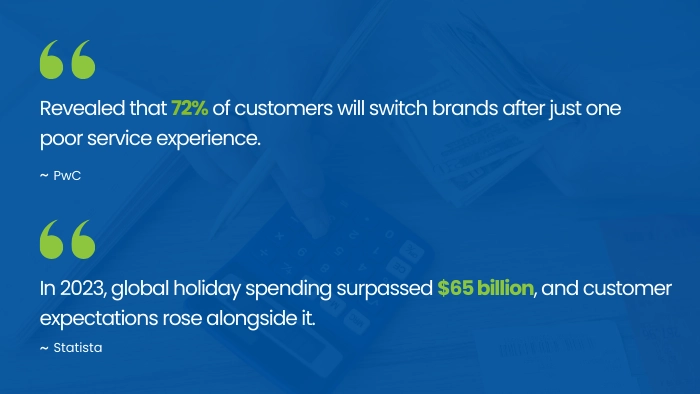
1: Staffing: Building a Scalable Workforce for Peak-Season Volume
Most organizations underestimate how significantly customer contact increases during the Holiday Season. Many businesses experience a 3–5× spike in customer interactions during peak days (Zendesk CX Report 2024). The surge is immediate and unrelenting, and staffing must account for not only increased volume but also more complex support scenarios.
A common mistake is relying solely on internal staff to stretch across the surge. Internal teams often lack peak-season experience and are already busy with ongoing responsibilities. This is why many brands partner with contact center outsourcing companies, blending in-house expertise with BPO agents who can absorb overflow across voice and non-voice channels.
The smartest staffing models combine both teams to support:
- Inbound & outbound calls
- Live chat & email
- Social media support
- After-hours customer service
Outsourced teams scale quickly, provide 24/7 coverage, and are trained to handle high-volume environments, reducing onboarding time significantly.
Forecasting is another crucial component. Reviewing historical trends, aligning with marketing calendars, and studying industry patterns helps organizations accurately anticipate volume. With up to 60% of Holiday Season purchases influenced by pre-event promotions (Salesforce), support demand begins rising weeks in advance. Staffing early prevents costly backlogs.
2: Training: Strengthening the Human Element for High-Pressure Interactions
The Holiday Season is emotionally charged for customers. They expect not just quick answers but reassurance, clarity, and reliable support. Training is therefore one of the most decisive factors in peak-season success.
Agents need strong product knowledge and must be prepared to answer queries about policies, shipping timelines, promotions, warranties, and inventory. A Gallup study found that 70% of customer dissatisfaction stems from poor agent knowledge, not product flaws.
The pressure during peak days can overwhelm even seasoned agents. Training must emphasize:
- Staying calm during high queues
- Managing multiple conversations
- Communicating clearly under pressure
- Using systems efficiently
Scenario-based training is extremely effective. Simulated Holiday-Season practice sessions help agents experience real-time surges, preparing them to juggle high chat volumes, solve problems faster, and navigate customer emotions. Intercom reports a 30% increase in readiness with simulation-based training.
Omnichannel competency is also vital. Customers may reach out via chat, email, Instagram, and phone simultaneously. Without unified training, agents give inconsistent responses. This is where omnichannel platforms and helpdesk outsourcing services help centralize all communication channels to provide consistency and reduce frustration.
3: Systems: Ensuring Technology Can Withstand Peak-Season Pressure
Technology forms the backbone of Holiday Season operations. This period exposes every weakness, slow websites, overloaded phone systems, ticketing delays, and CRM slowdown.
Customers expect fast, seamless service. According to Gartner, companies using modern omnichannel systems experience:
- 35% faster response times
- Significantly fewer escalations
Your systems including CRM, telephony, chat, website, and order management must be optimized for increased load. Even a few seconds of delay per interaction can snowball into hours of backlog.
Automation is crucial during the holidays.
“Automating order tracking, shipping updates, FAQs, and basic product queries can eliminate 20–30% of customer tickets during high-volume periods (McKinsey).”
This frees agents to focus on complex issues requiring empathy and problem-solving.
System testing must begin weeks ahead:
- Load testing
- Website stress testing
- Ticket routing validation
- Concurrency tests for chat systems
- Failover simulations for payment and order platforms
Holiday Season is not the time to discover that your CRM slows down under pressure.
Unifying all systems into a cohesive workflow ensures that agents have fast, powerful tools and customers immediately feel the difference.
4: A Realistic Holiday Season Scenario: How the Three Pillars Work Together
Imagine a mid-size e-commerce retailer that struggled last holiday season with long wait times, overwhelmed agents, and inconsistent responses. Customer satisfaction plummeted, and many shoppers abandoned their carts.
This year, they took a strategic approach:
- Staffing: They partnered with a contact center outsourcing company to scale support across all channels.
- Training: Internal and outsourced teams underwent unified training on product knowledge, store policies, communication clarity, and omnichannel handling.
- Systems: They implemented an omnichannel platform, automated shipping inquiries, integrated CRM with order management, and conducted full system stress testing.
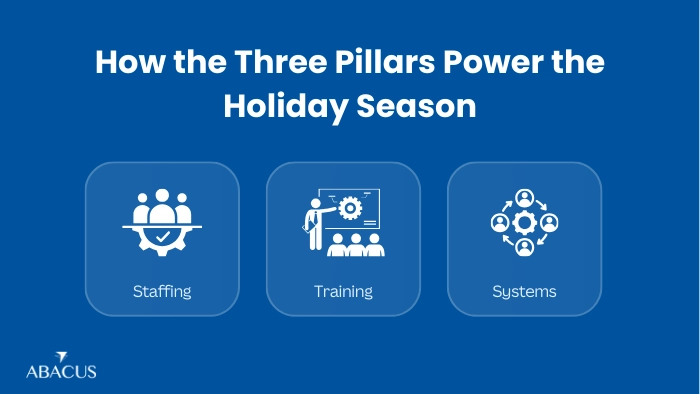
The results were dramatic:
- Response times improved from 18 minutes to under 5
- Cart abandonment dropped by 12%
- Sales increased by 27%
- Customer satisfaction rose by 32%
This is the power of synchronized staffing, training, and system readiness during the Holiday Season.
Conclusion: Holiday Season Success Isn’t Accidental, It’s Engineered with Abacus Outsourcing
The Holiday Season is not only the biggest shopping period of the year, it’s a defining moment for customer loyalty. With customer expectations at record highs and tolerance at historic lows, businesses cannot afford operational gaps, slow responses, or unprepared teams.
Success requires precision across staffing, training, and system readiness.
This is where Abacus Outsourcing empowers growing brands. With scalable staffing models, professionally trained agents, and advanced technology built for peak-season pressures, Abacus ensures businesses remain responsive, efficient, and customer-centric no matter how high the volume surges.
From omnichannel support to real-time operational visibility, Abacus transforms the chaos of the Holiday Season into a smooth, reliable, and memorable customer experience.
Brands that work with Abacus don’t just survive the Holiday Season; they thrive through it. They deliver faster resolutions, eliminate bottlenecks, protect their reputation, and turn once-a-year shoppers into loyal, returning customers.
With Abacus Outsourcing, Holiday Season success isn’t left to chance; it’s strategically engineered.

